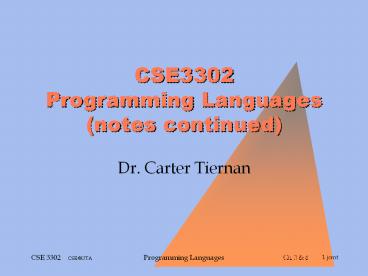CSE 3302CSE@UTA PowerPoint PPT Presentation
Title: CSE 3302CSE@UTA
1
CSE3302Programming Languages(notes continued)
- Dr. Carter Tiernan
2
Generality and HierarchyAlgol-60
- Close as possible to standard mathematical
notation and readable - Usable for describing computing processes
- Mechanically translatable to machine language
3
Algol Design
- Hierarchical structure / Nesting
- (unlike C C)
- Declarative and Imperative constructs
- Variable, procedure, and switch
- Computational and control-flow
- Compilation handled differently than Fortran
- Stack for run-time structures
4
Algol Name Structures
- Names are NOT statically bound
- Block structure supports scoping
- Blocks are compound statements
with declarations - Scope - contour diagrams
- Context
- Inner blocks implicitly inherit access to
variables in its immediately surrounding block
5
Algol Blocks
- Allows shared data to be easily organized with
the subprograms that need it (but does allow
indiscriminate access) - Scoping choices
- Static called in the environment of its
definition (used exclusively in Algol) - Dynamic called in the environment of its caller
6
Dynamic Scoping
- Called in environment of caller
- Can write general procedures that make use of
variables and procedures supplied by callers
environment - Vulnerable to being called from an environment
without correct supporting procedures - Not generally used in current languages
7
Static Scoping
- Called in the environment of its definition
- Requires the user to pass parameters of local
environment - Cannot behave differently based on call location
only - Ensures that the static structure of the program
more closely agrees with the dynamic behavior of
the program.
8
Algol Stacks for management
- Disjoint blocks allow conservation of memory on
the stack - Assumption a variable is retained only so long
as the program is executing in the scope of that
variable or in a block that will return to the
scope of that variable - Blocks follow LIFO execution ergo, a
stack handles the activation records in
a LIFO fashion
9
Responsible Design
- Understand the programmers problem
- Provide a high quality solution
- Which is not necessarily the solution the
programmers (or users) asked for - Responsible Design Principle
- Caveat If the user wants it and you dont
supply it (in their fashion), they may not accept
your alternate (even if better) solution
10
Algol Data Structures
- Primitives are scalars
- Boolean, integer, and real
- No double precision because its machine
dependent - No complex due to tradeoffs of usefulness vs.
complexity - Limited string type that required procedures
coded in some other language in order to be
output or used
11
Zero-One-Infinity Principle
- Supports regularity - easier to learn, remember,
and master - Eliminates arbitrary numerical limits
- Applies to arrays in
- Number of dimensions
- Start and end values for indices
12
Algol Arrays
- Generalized
- Dynamic due to stack allocation
Data Types
- Strong typing
- Coercions and conversions
- Type system as safety feature
13
Algol Control structures
- Primitives
- Assignment
- No input/output - handled with library routines
- Structures
- Regularize the FORTRAN structures
- if condition then statement1 else statement2
- for initialization keyword test do statement
14
Algol Control and nesting
- All control structures can handle arbitrary
number of bracketed statements - Compound statements formed with begin and end
- Algol structuring led to Dijkstras letter, GOTO
Considered Harmful
15
Algol More control
- Hierarchical structure
- Structured programming
- Recursion supported
- Instantiation of locals
- Every call creates a new activation record
- Conditional expression
16
Algol Parameter passing
- Passing by value
- Local copy of parameter
- Requires keyword value
- Pass by name
- Default mode
- Based on substitution - Copy Rule
- Not actually substituted for formal params
17
Algol Pass by name
- Compare to pass by reference
- Name parameters bound to string
- Jensens device
- Use pass by name with index variable to cycle
through array elements - Implementation - thunk
- Compile parameter
- Pass address of compiled parameter code
- Inconsistent behavior
18
Language Design Issues
- GO TO controversy
- Conceptual models
- System image
- Feature interaction
19
Algol Control (more)
- Out of block GO TOs
- Levels of activation must be popped
- For-loop
- For-list-elements reevaluated every pass
- Step, until
- While
- Enumerated list
- All of the above
- Baroque
20
Algol Control etal.
- Switch declaration
- Array of statement labels
- Processes cases - not necessarily distinct
- Best use recombines after cases
- Difficult to correlate with dynamic structure
- Baroque
21
Algol Syntactic Structures
- Machine independent / portable
- Free-format
- Programmers had to think about how it should look
- Reflect the structure of the program
- Independent of character sets
- Reference language
- Publication language
- Hardware representation
22
Algol Lexics
- Lexical conventions
- Reserved words
- Keywords (Algol approach)
- Keywords in context
- Dangling else
- Style
23
Backus-Naur Form (BNF)
- Precise programming language descriptions
- English difficult to read
- Examples incomplete
- Perceptual clarity with precision
- Backus - syntactic categories
- Naur added improvements to notation
- Metalanguage
24
BNF
- Terminals
- Nonterminals
- Defined in terms of nonterminals and terminals
- Recursive definition allowed
- Related to Chomsky language hierarchy
- Context-free grammar
- Regular (non-recursive) grammar
25
Design Criteria
- Efficiency - scientific issues
- Minimize resources
- Maximize safety
- Economy - social issues
- Maximize social benefit
- Minimize cost
- Elegance - aesthetic issues
- Function follows form
- Manifest interactions
26
Second Generation Languages
- Elaborations and generalizations of first
generation languages - Stronger typing
- Hierarchical structure
- Blocks
- Control flow
- Recursion
- Parameter passing modes
- Free-format syntax
- Machine independent conventions
- Reserved word/ Keywords
2nd

